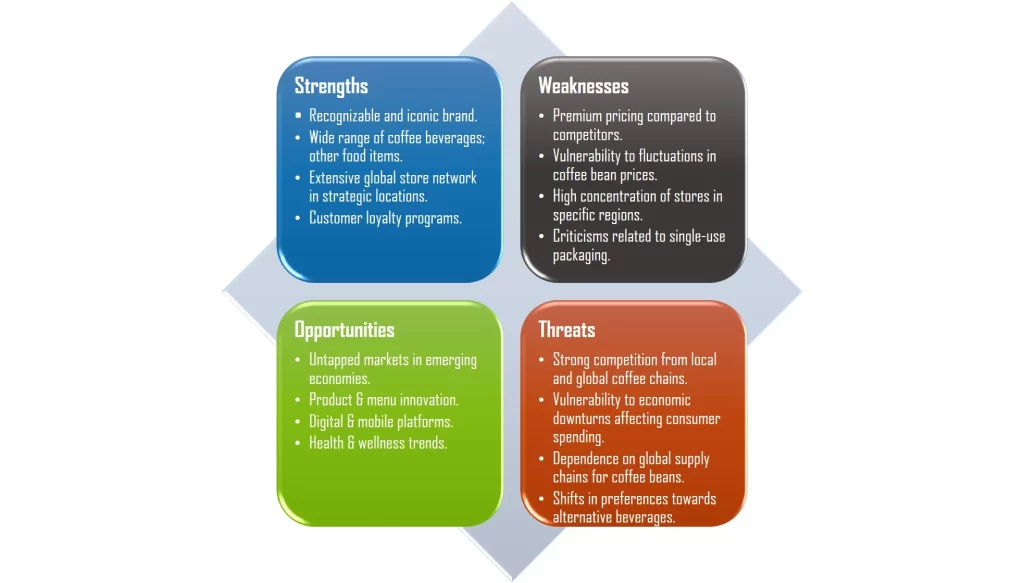
Below is a sample SWOT analysis essay on Starbucks Corporation. This example is intended to help students write better business analysis essays.
Starbucks Corporation SWOT Analysis Essay
SWOT Analysis Essay Outline: Starbucks Corporation
- Introduction:
- Company: Starbucks Corporation
- Date of Establishment: March 30, 1971
- Founders: Gordon Bowker, Zev Siegl, Jerry Baldwin
- Industry: Coffeehouse; world’s largest coffeehouse chain
- Locations: 38,038 (2023)
- CEO: Laxman Narasimhan (Mar 2023 –)
- Headquarters: Seattle, Washington, United States
- No. of Employees: approx. 402,000 (2022)
- Type: Public
- Ticker Symbol: SBUX (NASDAQ)
- Revenue: US $32.25 billion (2022)
- Net Income: US $3.28 billion (2022)
- Competitors: McDonald’s, Dunkin’ Donuts, Tim Hortons, McCafé, Peet’s Coffee, Lavazza, Folgers, Costa Coffee, The Coffee Bean, Global Tea Brands.
- Strengths:
- Global Brand Recognition:
- Recognizable and iconic brand.
- Strong global presence.
- Product Diversification:
- Wide range of coffee beverages.
- Expanding menu to include snacks and food items.
- Store Network:
- Extensive global store network.
- Strategic locations, including high-traffic urban areas.
- Customer Loyalty Programs:
- Successful implementation of rewards programs.
- Building and maintaining customer loyalty.
- Weaknesses:
- High Price Points:
- Premium pricing compared to competitors.
- Potential limitation in price-sensitive markets.
- Dependence on Coffee Beans:
- Vulnerability to fluctuations in coffee bean prices.
- Impact on operating costs and profit margins.
- Store Concentration in Certain Regions:
- High concentration of stores in specific regions.
- Exposure to regional economic downturns.
- Environmental Impact:
- Criticisms related to single-use packaging.
- Opportunities for improvement in sustainable practices.
- Opportunities:
- Market Expansion:
- Untapped markets in emerging economies.
- Potential for increasing global market share.
- Product and Menu Innovation:
- Continuous innovation in beverage and food offerings.
- Responding to changing consumer preferences.
- Digital and Mobile Platforms:
- Growth in online and mobile ordering.
- Opportunities for enhancing digital customer experience.
- Health and Wellness Trends:
- Increasing consumer interest in healthier alternatives.
- Opportunities for introducing more health-conscious options.
- Threats:
- Intense Competition:
- Strong competition from local and global coffee chains.
- Pressure to differentiate and innovate.
- Economic Downturns:
- Vulnerability to economic downturns affecting consumer spending.
- Impact on discretionary spending on premium coffee.
- Supply Chain Disruptions:
- Dependence on global supply chains for coffee beans.
- Risks of disruptions affecting availability.
- Changing Consumer Preferences:
- Shifts in preferences towards alternative beverages.
- Adapting to trends in the beverage industry.
- Conclusion:
- Summary of key findings from the Starbucks SWOT Analysis.
- Implications for Starbucks’ strategic planning and future actions.
This SWOT Analysis outline provides a structured framework for assessing Starbucks’ internal strengths and weaknesses, as well as external opportunities and threats in the coffee and retail industry.

